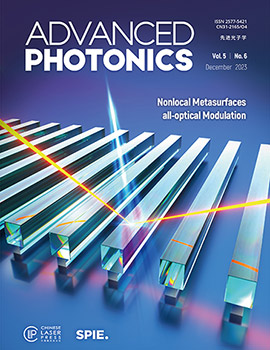用于高通量定量相位显微镜的混合明场和暗场强度传输方法
IF 18.8
1区 物理与天体物理
Q1 OPTICS
引用次数: 5
摘要
摘要强度传输方程(TIE)是一种公认的非干涉相位检索方法,通过简单地测量多个轴向位移平面上的强度图像,实现了定量相位成像(QPI)。基于TIE的QPI系统的优点是它与部分相干照明兼容,这提供了分辨率超过相干衍射极限的无斑点成像。然而,TIE通常用明场(BF)配置来实现,并且可实现的最大成像分辨率仍然被限制在非相干衍射极限(相干衍射极限的两倍)。希望与TIE相关的方法能够超过这一限制,并实现高通量[高分辨率和宽视场(FOV)]QPI。我们提出了一种用于高通量定量相位显微镜的BF和暗场强度传输(HBDTI)混合方法。通过低数值孔径(NA)物镜获取与BF和暗场照明相对应的两个过焦强度堆栈。然后,可以基于考虑相干模型分解的迭代相位检索算法来合成高分辨率和大FOV复振幅(定量吸收和相位分布)。通过检索USAF分辨率目标和不同类型的生物细胞,实验验证了该方法的有效性。实验结果表明,半幅成像分辨率可以从1230nm提高到488nm × 跨越4 × 7.19的FOV mm2,对应于6.25 × 空间带宽乘积从~5增加到~30.2 百万像素。与仅使用BF照明的传统基于TIE的QPI方法相比,HBDTI的合成孔径过程进一步结合了暗场照明,以扩展可访问的对象频率,从而将最大可用分辨率从2NA显著扩展到~5 NA × 相干衍射极限的提高。鉴于其高通量QPI的能力,所提出的HBDTI方法有望在生物医学领域采用,如个性化基因组学和癌症诊断。本文章由计算机程序翻译,如有差异,请以英文原文为准。
Hybrid brightfield and darkfield transport of intensity approach for high-throughput quantitative phase microscopy
Abstract. Transport of intensity equation (TIE) is a well-established non-interferometric phase retrieval approach that enables quantitative phase imaging (QPI) by simply measuring intensity images at multiple axially displaced planes. The advantage of a TIE-based QPI system is its compatibility with partially coherent illumination, which provides speckle-free imaging with resolution beyond the coherent diffraction limit. However, TIE is generally implemented with a brightfield (BF) configuration, and the maximum achievable imaging resolution is still limited to the incoherent diffraction limit (twice the coherent diffraction limit). It is desirable that TIE-related approaches can surpass this limit and achieve high-throughput [high-resolution and wide field of view (FOV)] QPI. We propose a hybrid BF and darkfield transport of intensity (HBDTI) approach for high-throughput quantitative phase microscopy. Two through-focus intensity stacks corresponding to BF and darkfield illuminations are acquired through a low-numerical-aperture (NA) objective lens. The high-resolution and large-FOV complex amplitude (both quantitative absorption and phase distributions) can then be synthesized based on an iterative phase retrieval algorithm taking the coherence model decomposition into account. The effectiveness of the proposed method is experimentally verified by the retrieval of the USAF resolution target and different types of biological cells. The experimental results demonstrate that the half-width imaging resolution can be improved from 1230 nm to 488 nm with 2.5 × expansion across a 4 × FOV of 7.19 mm2, corresponding to a 6.25 × increase in space-bandwidth product from ∼5 to ∼30.2 megapixels. In contrast to conventional TIE-based QPI methods where only BF illumination is used, the synthetic aperture process of HBDTI further incorporates darkfield illuminations to expand the accessible object frequency, thereby significantly extending the maximum available resolution from 2NA to ∼5NA with a ∼5 × promotion of the coherent diffraction limit. Given its capability for high-throughput QPI, the proposed HBDTI approach is expected to be adopted in biomedical fields, such as personalized genomics and cancer diagnostics.
求助全文
通过发布文献求助,成功后即可免费获取论文全文。
去求助
来源期刊

Advanced Photonics
OPTICS-
CiteScore
22.70
自引率
1.20%
发文量
49
审稿时长
18 weeks
期刊介绍:
Advanced Photonics is a highly selective, open-access, international journal that publishes innovative research in all areas of optics and photonics, including fundamental and applied research. The journal publishes top-quality original papers, letters, and review articles, reflecting significant advances and breakthroughs in theoretical and experimental research and novel applications with considerable potential.
The journal seeks high-quality, high-impact articles across the entire spectrum of optics, photonics, and related fields with specific emphasis on the following acceptance criteria:
-New concepts in terms of fundamental research with great impact and significance
-State-of-the-art technologies in terms of novel methods for important applications
-Reviews of recent major advances and discoveries and state-of-the-art benchmarking.
The journal also publishes news and commentaries highlighting scientific and technological discoveries, breakthroughs, and achievements in optics, photonics, and related fields.
 求助内容:
求助内容: 应助结果提醒方式:
应助结果提醒方式:


